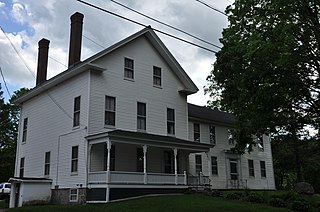
The Daniel Webster Family Home, also known as The Elms, is a historic house off South Main Street in West Franklin, New Hampshire. The house has been designated a National Historic Landmark for its importance as the summer home of Daniel Webster (1782–1852), who owned it from 1829 until his death.

Wakefield station is an MBTA Commuter Rail station in Wakefield, Massachusetts served by the Haverhill Line. The station has two side platforms, which are not accessible, serving the line's two tracks. The station building, constructed in 1889, was listed on the National Register of Historic Places in 1989 as Wakefield Upper Depot.

The Lovell Block is an historic residential and commercial building at 1853 Massachusetts Avenue in Cambridge, Massachusetts. The three-story brick building was built in 1882 by Andrew Jackson Lovell, with two specific commercial tenants in mind. One was his own grocery business, and the other was the North Cambridge Post Office. The upper floors contained a total of four well-appointed residential flats. The building was an early instance of a mixed-use residential-commercial structure, at a time when most lower-income housing was tenement-style, and the idea of higher-quality residential rental property was relatively new.

The Main Street Historic District encompasses the historic late 19th and early 20th-century commercial heart of Webster, Massachusetts. It consists of fourteen buildings on Main Street in downtown Webster, between High and Church Streets. This area contains the highest concentration of period commercial buildings in the town. The district was listed on the National Register of Historic Places in 1982.

Court Square is the central plaza and historic district in Springfield, Massachusetts. It is located in the heart of Springfield's urban Metro Center neighborhood. Court Square is the City of Springfield's only topographical constant since its founding in 1636.

Downtown Fall River Historic District is a historic district on North and South Main, Bedford, Granite, Bank, Franklin, and Elm Streets in Fall River, Massachusetts.
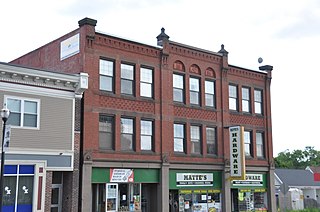
The Shumway Block is a historic commercial building in Webster, Massachusetts. Built in 1887, it is a well-preserved local example of late Victorian commercial brick architecture, and has played a prominent role in the business economy of the Webster downtown's west end. The block was listed on the National Register of Historic Places in 1980.

The Eddy Block is a historic commercial building in Webster, Massachusetts. The three-story brick building was built by Lyman R. Eddy in 1878 on the site of a previous block which had been destroyed by fire. The Gothic Revival building has had a variety of tenants, including the post office, a district court, the Masonic Lodge, and the Webster Times.
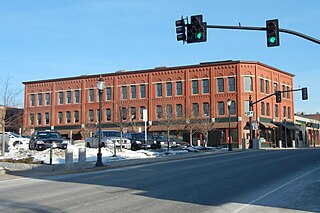
The Masonic Block is an historic commercial block in Reading, Massachusetts. This three-story brick building is distinctive in the town for its Renaissance Revival styling. It was built in 1894 by the local Reading Masonic Temple Corporation, and housed the local Masonic lodge on the third floor. The building was listed on the National Register of Historic Places in 1984.

The Oddfellows Building is a historic mixed-use commercial building at Central Square in Stoneham, Massachusetts. Built in 1868, it is one of three Second Empire buildings that give downtown Stoneham its character, despite some exterior alterations. It was added to the National Register of Historic Places in 1984, and was included in the Central Square Historic District in 1990.

The Central Square Historic District is a historic district encompassing much of the central business district of Stoneham, Massachusetts. It includes the town's largest concentration of 19th and early-20th century commercial architecture, in an area that developed in importance as a commercial center after the construction of the Andover-Medford Turnpike. The district was added to the National Register of Historic Places in 1990.

The Dow Block is a historic commercial building on Central Square in Stoneham, Massachusetts. Built in 1864, it is the first of three mid-19th century buildings that define Central Square, and is a fine example of Second Empire architecture. The building was listed on the National Register of Historic Places in 1984, and was included in the Central Square Historic District in 1990.

Flanley's Block is a historic commercial building at 349–353 Main Street in Wakefield, Massachusetts, US. Built about 1895, it is a well-preserved local example of late 19th-century Italianate commercial architecture. The building was listed on the National Register of Historic Places in 1989.

The Item Building is a historic commercial building at 26 Albion Street in Wakefield, Massachusetts. Built in 1912, the single-story brick building serves as the headquarters of The Wakefield Daily Item, Wakefield's main community newspaper, and is a well-kept example of early 20th century commercial architecture.

The Wakefield Trust Company is a historic commercial building at 371 Main Street in Wakefield, Massachusetts. Built in 1924, it is one of three buildings on the west side of Main Street that give the town center a strong Classical Revival flavor. The building was listed on the National Register of Historic Places in 1989.
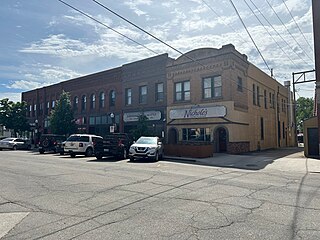
The Knerr Block, Floyd Block, McHench Building and Webster and Coe Building is a set of four buildings in Fargo, North Dakota that was listed on the National Register of Historic Places in 1983. The four buildings were built in 1900, 1902, and 1910. The oldest, the Webster and Coe building, was built in 1900 by a carpenter or contractor named Martel. The McHench Building was designed by the Hancock Brothers architects. The "four adjacent buildings constitute a solid front of excellent early turn-of-the-century commercial structures, displaying a continuity of fenestration and decorative brickwork."

The Telephone Co. Building in Grand Forks, North Dakota, United States, was built in 1904. It was listed on the National Register of Historic Places in 1982.
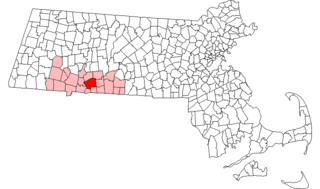
This is a list of the National Register of Historic Places listings in Springfield, Massachusetts.

Colony's Block is a historic commercial building at 4-7 Central Square in the heart of Keene, New Hampshire. The five-story brick building was built in 1870 to a design by Worcester, Massachusetts, architects E. Boyden & Son, and is the city's most prominent example of Second Empire architecture. In addition to being a long-standing commercial center, the building housed the city library from 1870 to 1877. The building was listed on the National Register of Historic Places in 1983.

The Grinnell Historic Commercial District is a nationally recognized historic district located in Grinnell, Iowa, United States. It was listed on the National Register of Historic Places in 1991. At the time of its nomination it contained 75 resources, which included 47 contributing buildings, and 26 non-contributing buildings. The historic district is the core of the city's central business district. Fires struck the area in 1889 and twice in 1891. They destroyed the frame buildings, and were replaced with brick and stone structures, although Block 7 developed more slowly. Most of the buildings are two stories in height, six buildings are single-story structures, and two are three stories. The economic development of the city was also assisted by the presence of Grinnell College and the presence of two railroads.























